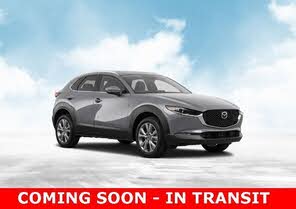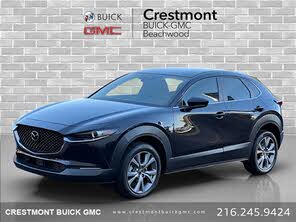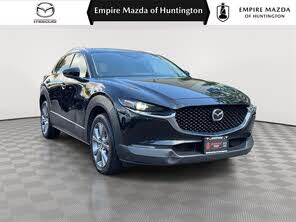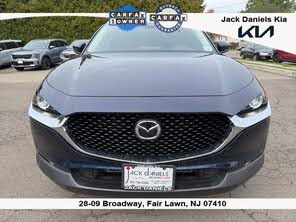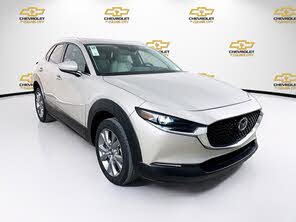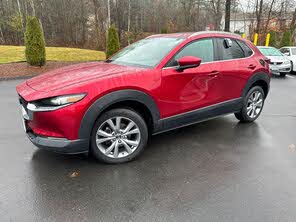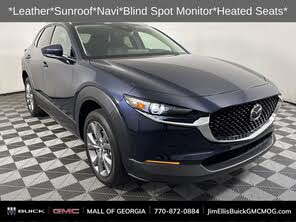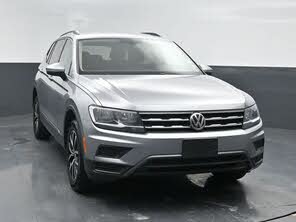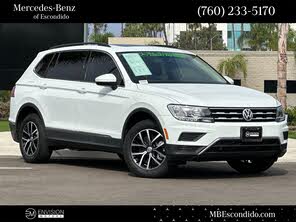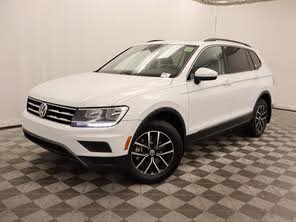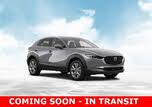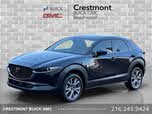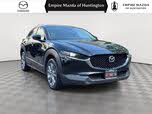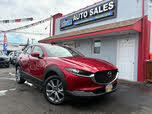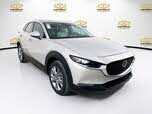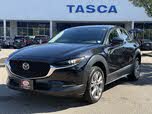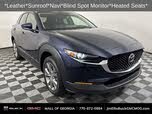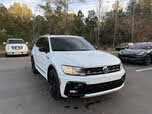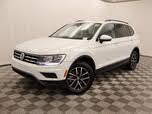2022 Mazda CX-30 vs 2021 Volkswagen Tiguan
Overview | |
MSRP$25,245 | MSRP$22,200 |
Listings1315 | Listings700 |
Ratings & Reviews | |
User Reviews | User Reviews |
Expert reviews7.3 out of 10 | Expert reviews8.0 out of 10 |
Pros
Cons
| Pros
Cons
|
2021 Volkswagen Tiguan Reviews SummaryYou may have noticed that crossover SUVs are popular. Among them, compact models dominate, having essentially replaced the traditional midsize sedan in American driveways. Offering room for five people, available all-wheel drive (AWD), and more cargo than any family car, they are the preferred method of transportation for a broad cross section of new vehicle buyers. But that’s not the only explanation for the runaway success of the 2021 Volkswagen Tiguan. | |
2022 Mazda CX-30 Reviews SummaryAs a brand, Mazda has been punching above its weight for well over a decade now. Whether it’s the three-row CX-9 SUV or Mazda3 compact car, you can expect a higher-quality interior and a more refined ride than respective rivals in a given segment. This is no different for the 2022 Mazda CX-30. The CX-30 is a subcompact crossover SUV introduced as a 2020 model, supplementing the similar-sized Mazda CX-3. It carries over to the 2022 model year, just as the CX-3 has been discontinued. The CX-30 addresses the shortcomings of the CX-3 without losing any of that crossover’s positive attributes. The CX-30 has a more spacious cabin than the CX-3, but retains the fun-to-drive nature, and has an even more upscale cabin. Read on to learn how Mazda’s new subcompact SUV stands out within this popular vehicle segment. | |
No video found | No video found |
Popular Features & Specs | |
Engine2.0L 184 hp I4 | Engine2.5L 186 hp I4 |
Drive TrainFWD | Drive TrainAWD |
Seating Capacity7 | Seating Capacity5 |
Horsepower184 hp @ 4400 rpm | Horsepower186 hp @ 6000 rpm |
MPG City23 | MPG City24 |
MPG Highway29 | MPG Highway31 |
Engine | |
Engine Name2.0L 184 hp I4 | Engine Name2.5L 186 hp I4 |
Torque221 lb-ft @ 1600 rpm | Torque186 lb-ft @ 4000 rpm |
Horsepower184 hp @ 4400 rpm | Horsepower186 hp @ 6000 rpm |
DrivetrainFWD | DrivetrainAWD |
Fuel Economy | |
MPG City23 | MPG City24 |
MPG Highway29 | MPG Highway31 |
Interior | |
Seating Capacity7 | Seating Capacity5 |
Safety | |
Front Crash Overall4 | Front Crash Overall5 |
Side Crash Overall5 | Side Crash Overall5 |
Dimensions & Capacity | |
Cargo Space12.0 cu ft | Cargo Space20.2 cu ft |
Curb Weight3735 lbs | Curb Weight3388 lbs |
Height66.3 in | Height61.7 in |
Length185.1 in | Length173.0 in |
Width72.4 in | Width70.7 in |
Wheelbase109.8 in | Wheelbase104.4 in |
Maximum Payload1146 lbs | Maximum Payload993 lbs |
Number of doors4 | Number of doors4 |
Maximum Towing Capacity1500 lbs | Maximum Towing Capacity |
Overview | ||
MSRP | $25,245 | $22,200 |
Listings | ||
Ratings & Reviews | ||
User reviews | ||
Expert reviews | 7.3 out of 10Read full review | 8.0 out of 10Read full review |
Pros & cons | Pros
Cons
| Pros
Cons
|
Summary | You may have noticed that crossover SUVs are popular. Among them, compact models dominate, having essentially replaced the traditional midsize sedan in American driveways. Offering room for five people, available all-wheel drive (AWD), and more cargo than any family car, they are the preferred method of transportation for a broad cross section of new vehicle buyers. But that’s not the only explanation for the runaway success of the 2021 Volkswagen Tiguan. | As a brand, Mazda has been punching above its weight for well over a decade now. Whether it’s the three-row CX-9 SUV or Mazda3 compact car, you can expect a higher-quality interior and a more refined ride than respective rivals in a given segment. This is no different for the 2022 Mazda CX-30. The CX-30 is a subcompact crossover SUV introduced as a 2020 model, supplementing the similar-sized Mazda CX-3. It carries over to the 2022 model year, just as the CX-3 has been discontinued. The CX-30 addresses the shortcomings of the CX-3 without losing any of that crossover’s positive attributes. The CX-30 has a more spacious cabin than the CX-3, but retains the fun-to-drive nature, and has an even more upscale cabin. Read on to learn how Mazda’s new subcompact SUV stands out within this popular vehicle segment. |
Video | No video found | No video found |
Popular Features & Specs | ||
Engine | 2.0L 184 hp I4 | 2.5L 186 hp I4 |
Drive Train | FWD | AWD |
Seating Capacity | 7 | 5 |
Horsepower | 184 hp @ 4400 rpm | 186 hp @ 6000 rpm |
MPG City | 23 | 24 |
MPG Highway | 29 | 31 |
Engine | ||
Engine Name | 2.0L 184 hp I4 | 2.5L 186 hp I4 |
Torque | 221 lb-ft @ 1600 rpm | 186 lb-ft @ 4000 rpm |
Horsepower | 184 hp @ 4400 rpm | 186 hp @ 6000 rpm |
Drivetrain | FWD | AWD |
Fuel Economy | ||
MPG City | 23 | 24 |
MPG Highway | 29 | 31 |
Interior | ||
Seating Capacity | 7 | 5 |
Safety | ||
Front Crash Overall | 4 | 5 |
Side Crash Overall | 5 | 5 |
Dimensions & Capacity | ||
Cargo Space | 12.0 cu ft | 20.2 cu ft |
Curb Weight | 3735 lbs | 3388 lbs |
Height | 66.3 in | 61.7 in |
Length | 185.1 in | 173.0 in |
Width | 72.4 in | 70.7 in |
Wheelbase | 109.8 in | 104.4 in |
Maximum Payload | 1146 lbs | 993 lbs |
Number of doors | 4 | 4 |
Maximum Towing Capacity | 1500 lbs | |
The 2021 Volkswagen Tiguan had an understated yet sophisticated design. Its clean lines and balanced proportions resonated with those who appreciated a conservative, upscale aesthetic that promised to age well. Measuring nearly as large inside as a Hyundai Santa Fe or Kia Sorento, the Tiguan boasted a generous interior space thanks to its second-generation upsizing. This SUV could comfortably accommodate up to seven passengers, though at least three of them needed to be children if the optional third-row seat was utilized.
Volkswagen’s knack for modern geometric interior forms combined with a straightforward control layout kept the Tiguan’s cabin user-friendly. However, some quirks existed, like the engine start button positioned to the upper left of the gear selector on the center console, an unusual placement in any vehicle. Shiny detailing, digital instrumentation, and an integrated touchscreen infotainment system added a touch of sophistication. Yet, there was no forgetting the hard plastic surfaces and flimsy feeling steering wheel stalks, making sure you wouldn’t mistake the Tiguan for an Audi. With S, SE, and SEL trims available, along with the sporty SE R-Line Black and SEL Premium R-Line variants, the Tiguan’s price ranged between $25,245 and $39,095 (excluding destination charges).
In contrast, the 2022 Mazda CX-30 mirrored the design elements of its larger sibling, the CX-5, including a refined upright grille and smooth fenders. Riding on the same platform as the Mazda3, the CX-30 resembled a raised-up Mazda3 hatchback. Its dramatically raked windshield doubled as a greenhouse on sunny days—though not optimal for taller drivers due to the distorted view caused by its slight curve.
Inside, the CX-30’s cabin was a winning blend of comfort and quietness. The cabin’s solid build quality was audible in the firm closing of doors and tactile buttons. One of the best interior designs in the affordable car segment, the CX-30 combined conventional and digital displays within an artful instrument cluster, while the organic rise of the infotainment screen from the dashboard enhanced its elegance. However, the infotainment system—a nod to luxury setups like BMW’s iDrive—lacked touch functionality, making it cumbersome to navigate, especially when using Apple CarPlay or Android Auto.
















The 2021 Volkswagen Tiguan came equipped with a turbocharged 2.0-liter four-cylinder engine producing 184 horsepower at 4,360 rpm and 221 pound-feet of torque at 1,600 rpm. Power was channeled to the wheels through an eight-speed automatic transmission, with front-wheel drive as standard and the 4Motion all-wheel-drive system available for $1,400 on most models. Unfortunately, turbo lag was noticeable, making the Tiguan feel sluggish in certain driving conditions, and its nearly 4,000-pound curb weight only exacerbated this issue. With EPA ratings of 25 mpg combined for the FWD model and 24 mpg for the AWD model, the Tiguan fell short during testing, averaging only 22.6 mpg. Positively, it did offer light, responsive steering, a compliant ride, and refined braking, making it an ideal urban commuter. However, the Tiguan’s tendency to lose grip early in corners and allow excessive body motion deterred spirited driving.
The 2022 Mazda CX-30, on the other hand, offered two engine options. The base engine was a naturally aspirated 2.5-liter four-cylinder with 186 horsepower and 186 pound-feet of torque. Our tested model, however, featured the 2.5-liter turbocharged four-cylinder, delivering 227 hp and 310 lb-ft of torque on regular fuel and 250 hp and 320 lb-ft on premium fuel. This power was relayed through a six-speed automatic transmission to all four wheels. The turbocharged engine offered quick acceleration in most scenarios, and the Sport mode further sharpened its throttle response and shift mapping for a lively driving experience. The CX-30 excelled with precise, well-weighted steering and minimal body roll in corners, at the cost of a firmer ride over potholes and rough surfaces.
Inside the 2021 Volkswagen Tiguan, comfort reigned supreme. Large doors facilitated easy ingress and egress, while the front seats offered a wide range of adjustments, ensuring proper support and excellent visibility. The Tiguan included practical features such as perforated V-Tex leatherette upholstery and effective dual-zone climate control. Backseat occupants enjoyed ample legroom, foot space, air conditioning vents, and USB charging ports. The Tiguan’s large panoramic sunroof enhanced the cabin experience, adding openness without noise disruption. Storage was somewhat limited, but the cargo area compensated with a flexible 40/20/40-split folding rear seat, providing 33 to 37.6 cubic feet behind the second row, expandable to a maximum of 65.7 to 73.5 cubic feet.
Similarly, the 2022 Mazda CX-30 offered commendable interior space, with up to 45.2 cubic feet of cargo capacity when the rear seats were folded, and 20.2 cubic feet with the seats in use. The power rear liftgate on our model was particularly handy. However, the sliding center console cover proved problematic as it could get stuck under the seat with the lid open. Despite this flaw, the front console provided ample storage space, complemented by deep pockets in the door for large water bottles. Rear-seated passengers, though slightly cramped for headroom compared to the larger CX-5, found the space adequate for short-to-medium trips.
The 2021 Volkswagen Tiguan introduced the MIB3 infotainment system starting with the SE trim, featuring an 8-inch touchscreen, faster processing speeds, and advanced capabilities. Highlights included wireless Apple CarPlay and Android Auto, WiFi connectivity, SiriusXM 360L, Amazon Alexa compatibility, and a suite of Car-Net connected services. Despite the improvements, the interface had quirks, and the voice recognition technology fell short. The SEL Premium R-Line trim offered a nine-speaker Fender premium audio system, which performed significantly better than the standard six-speaker setup available in lower trims.
The 2022 Mazda CX-30, in contrast, adopted a different approach with its infotainment system. The CX-30's elegant dashboard seamlessly housed a non-touchscreen infotainment screen, controlled via a rotary dial/joystick and a series of toggle buttons. Inspired by luxury designs like BMW’s iDrive, the system sacrificed ease of use. Navigating through Apple CarPlay and Android Auto with the rotary dial proved frustrating, especially when trying to exit these interfaces. However, once set up, the system offered acceptable performance, though switching between presets remained cumbersome.
Volkswagen equipped the 2021 Tiguan with its IQ Drive suite, which included essential features like forward-collision warning, pedestrian detection, automatic emergency braking, blind-spot monitoring, and rear cross-traffic alert. Starting with the SE trim, adaptive cruise control was added, with lane-departure warning and lane-keep assist available from the SEL trim upward. The SEL Premium R-Line added automatic high-beam headlights. However, certain features, like the Tiguan’s parking sensors, could be overly sensitive. The standard reverse camera provided clarity, though the premium trims’ surround-view system offered superior visibility. The IIHS awarded the Tiguan a “Top Safety Pick” for its SEL and SEL Premium R-Line trims, while the NHTSA hadn’t published comprehensive crash test results.
The 2022 Mazda CX-30 came with an impressive array of standard driver-assistance features, which included forward collision avoidance, pedestrian detection, automatic high beams, lane-departure warning, lane-keeping assist, rain-sensing wipers, and adaptive cruise control. Our tested Turbo Premium Plus model included blind-spot monitoring, rear cross-traffic alert, traffic-sign recognition, front-and-rear parking sensors, reverse automatic emergency braking, and adaptive front headlights. The crisp head-up display was easily readable in various lighting conditions. The NHTSA awarded the CX-30 five stars in safety, while the IIHS named it a Top Safety Pick+ with high marks across all crash tests and driver-assistance evaluations.
CarGurus highlights

According to CarGurus experts, the overall rating for the 2021 Volkswagen Tiguan is 7.3 out of 10, while the 2022 Mazda CX-30 scores 8.0 out of 10. Based on these ratings, we recommend the 2022 Mazda CX-30. Its superior driving dynamics, premium interior quality, extensive standard safety features, and higher overall rating make it the better choice between these two SUVs.
Choose the 2022 Mazda CX-30 if:
- You seek a sporty, refined ride with well-weighted steering and quick, precise turn-in.
- You appreciate a premium interior design with solid build quality and a quiet cabin.
- You want a vehicle equipped with an extensive list of standard and advanced driver-assistance features for added safety.
Choose the 2021 Volkswagen Tiguan if:
- You value a spacious and accommodating interior with optional third-row seating for more flexibility.
- You prefer a vehicle with conservative styling and a simple, no-nonsense control layout.
- You need a vehicle with a wide range of advanced safety and driver-assistance features, even in lower trims.
CarGurus highlights

According to CarGurus experts, the overall rating for the 2021 Volkswagen Tiguan is 7.3 out of 10, while the 2022 Mazda CX-30 scores 8.0 out of 10. Based on these ratings, we recommend the 2022 Mazda CX-30. Its superior driving dynamics, premium interior quality, extensive standard safety features, and higher overall rating make it the better choice between these two SUVs.
Choose the 2022 Mazda CX-30 if:
Shop Now- You seek a sporty, refined ride with well-weighted steering and quick, precise turn-in.
- You appreciate a premium interior design with solid build quality and a quiet cabin.
- You want a vehicle equipped with an extensive list of standard and advanced driver-assistance features for added safety.
Choose the 2021 Volkswagen Tiguan if:
Shop Now- You value a spacious and accommodating interior with optional third-row seating for more flexibility.
- You prefer a vehicle with conservative styling and a simple, no-nonsense control layout.
- You need a vehicle with a wide range of advanced safety and driver-assistance features, even in lower trims.

By: CarGurus + AI
At CarGurus, our team of experienced automotive writers remain at the heart of our content operation, conducting hands-on car tests and writing insightful guides that are backed by years of industry experience. To complement this, we are harnessing AI to make our content offering more diverse and more helpful to shoppers than ever. To achieve this, our AI systems are based exclusively on CarGurus content, ratings and data, so that what we produce is both unique to CarGurus, and uniquely helpful to car shoppers.

